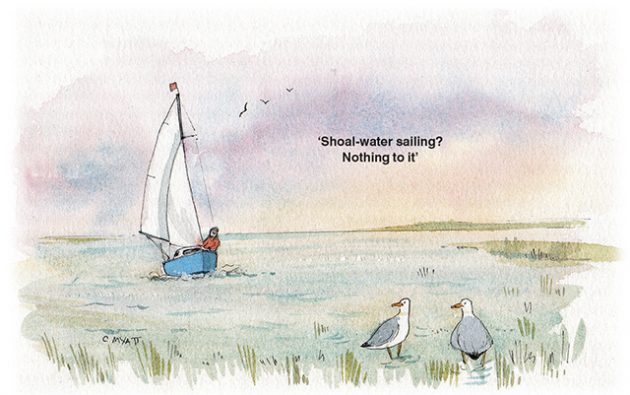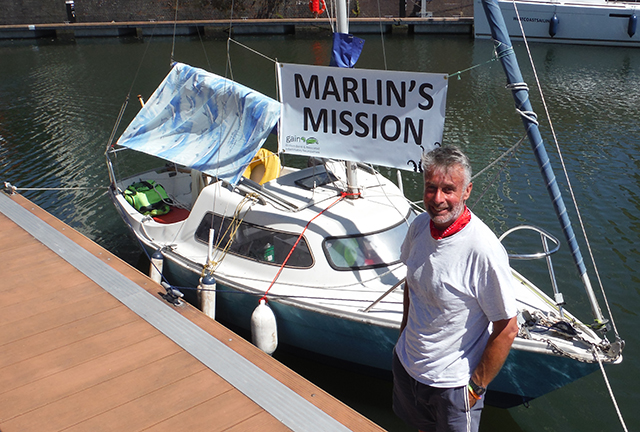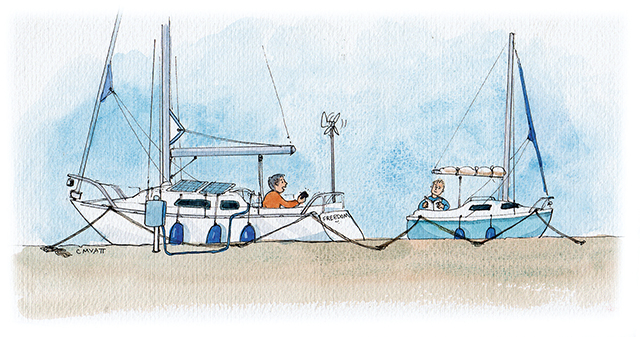If you’re simultaneously a bit shallow yet out of your depth when it comes to echo-sounders, a cup of tea can confer great dividends
For years I’ve relied on my trusty Seafarer echosounder.
That’s why I’ve also got a stick. And I knew something was up on a test sail in Marlin when my 1970s marvel of technology read a steady 4ft… constantly.
Nowhere on the East Coast is that deep!
And for once, the sages in The Queen’s Head were no help at all. They have a deep distrust of anything more modern than rickets and instead prefer to rely on their famous local knowledge.
You’ve got to respect that, cos not one of them has ever gone aground, although on any weekend you’ll find dozens of proper long-keelers expertly careened on muddy slopes to touch up their antifouling.
You’d be amazed at the remarkable heights scaled by some of the bilge-keelers in search of the perfect antifouling spot.
Of course, there are those who’ve embraced the more modern digital technology of lead lines, which are so prized round here they are often carried ashore and placed delicately in socks to protect them and muffle the blow.
So, frankly, when it came to fathoming my echo-sounder problem I was out of my depth.
That’s because the workings of Seafarers are shrouded in the lost arts of mystic lore and alchemy. Some say they’re even powered by myrrh, and that the little strobing red blip is a rare Peruvian male dung beetle striving forlornly to attract a mate.
Mine runs on a pagan PP9 battery. Except it didn’t.
Now here’s the practical bit.
The transducer sits in a tube which is supposed to be filled with magic oil. Instead I’d used water for years, which had gone all rancid and gloopy, so I cleaned out the tube and put baby oil in. No joy. Perhaps it wasn’t mature enough. Corn oil didn’t work either, nor extra-virgin olive oil.
This was getting costly, so I gave up. Neighbour Steve then traced the problem in two seconds to a loose connector on the coaxial cable. Doh!
Through the shallow Ray Sand channel from the Blackwater into the River Crouch my old Seafarer did fine work and gave me all the feedback I needed. But on the next leg, a shortcut into the Thames via the Roach and through the lifting bridge that crosses to the MoD firing range on Foulness Island, it was out of its league.
Fortunately I had something much better on board – my mate Tony Smith, AKA Creeksailor, who knows the Essex creeks like commuters know the M25 and drinks tea the colour of mud.
We were sailing in three feet, then two, as we probed the creeks on a rising tide, but with so little water an echo-sounder’s not telling you anything useful.
Instead Tony traced the contours of the tannin-hued shallows with my sounding pole, which I’d never used before. A sage pal had made it for me years ago and marked it with red and black bands that correspond with no known measurement, metric or imperial.
Of course, they could be cubits perhaps, but I’d lost the original manual. It was on a tablet – a stone one, I think.
I’d also picked the tide wrong – it was a neap – and the bridge-keeper doubted we’d get through, but Tony smiled and told me to lift the keel right up and partially raise the rudder.
Then I marvelled as Tony prodded with the stick and piloted Marlin through a serpentine labyrinth concealed by water the colour of tea.
Yes, we were actually sailing in one foot! And we didn’t touch once!
And all the time Tony calmly recited the depths in his own special units of measure he’d devised for our Tetleytoned waters: ‘two cups, three cups, four’. It was a mark of his skill that we never got down to ‘a saucer’.
He can read themessages in a teacup better than Gypsy Rose Lee.
With three feet, and the keel partially lowered, the Seafarer took over again until we picked up a buoy in Thorpe Bay, swam, then paddled on the sands, drank tea and walked ashore as Marlin took the ground.
Tony went home that night, but he left me with a precious gift. The following morning, just as Marlin lifted on the tide, I did something I’d never dared before. Prodding with my magic many-coloured cane I sailed off in one foot of water, a little less than four cups.
And then I twigged. Those red and black bands were each three-and-a-half inches, the height of the ideal tea mug.
As published in the September 2016 issue of PBO, on sale from tomorrow, Thursday 11 August.
Nav in a Nutshell: Navigate by ‘feel’ using an echo sounder
The ‘ping’ is king: You can navigate by ‘feel’ over the seabed in adverse conditions by using an echo sounder…
Best forward-looking sonar: 5 units tested
How effective is forward-looking sonar at flagging up shoals and obstacles on the seabed? David Pugh compares the findings from…
Sailfish challenger Dave Selby reaches London on his ‘last legs’
PBO's Dave Selby, who is battling a rare nerve illness, won a tense race against time to sail his 18ft…
The great UK antifouling test for cruising yachts
20 antifouling paints tested in 13 UK locations: which works best where you keep your boat?
What to do when you run aground
Whether you go to sea under power or sail, you'll almost certainly find yourself aground at some point in your…
The future of DIY antifouling: it’s apparently in your gloves
Antifouling paint product regulations set to change significantly over the next few years
Antifouling: Everything you need to know
Here’s PBO’s guide to preparing for, choosing and using antifouling paints
Nav in a nutshell: Navigating at night
There’s no need to be in the dark if your preparation is thorough and easy to understand, says Dick Everitt…
Ohm improvements – Dave Selby’s Mad about the Boat
Formerly ohmless and happy, ‘analogue Dave’ is now going digital
Why you should race your cruising boat
Ben Meakins finds out why – and how – PBO readers from around the UK go racing in their cruising














